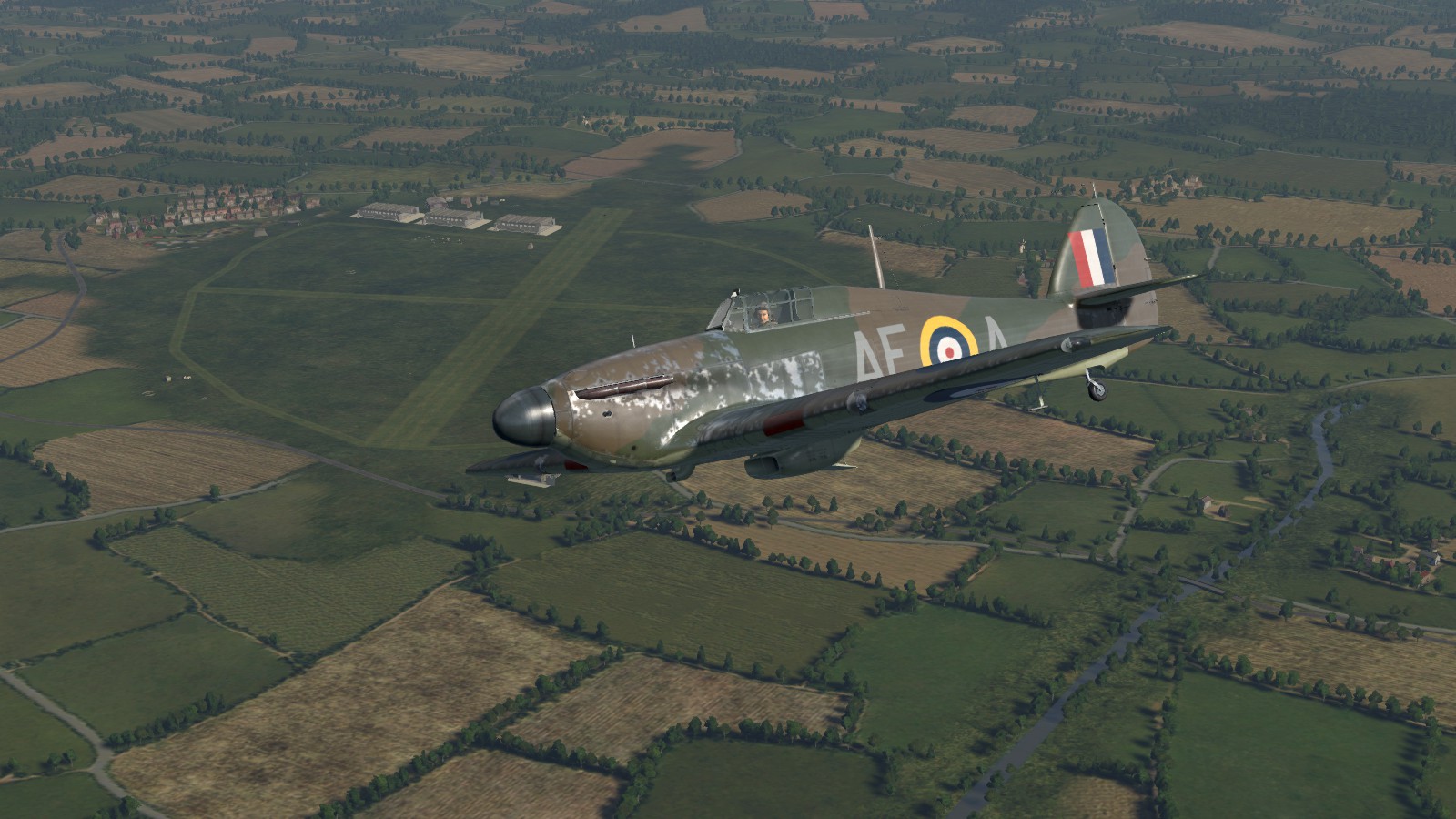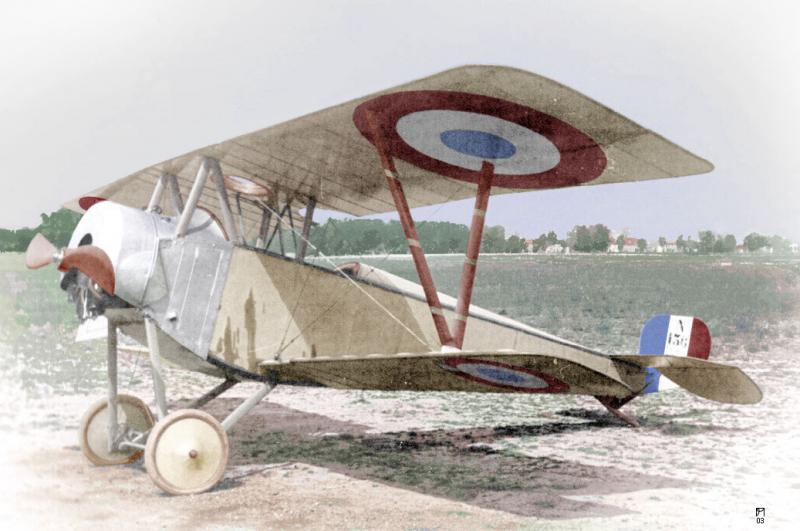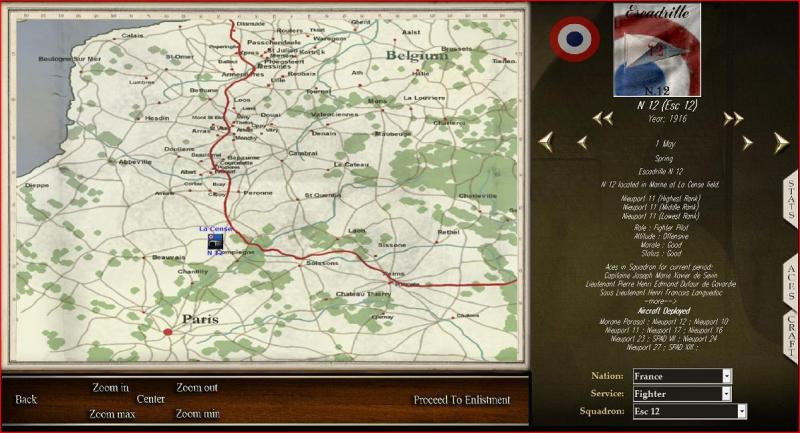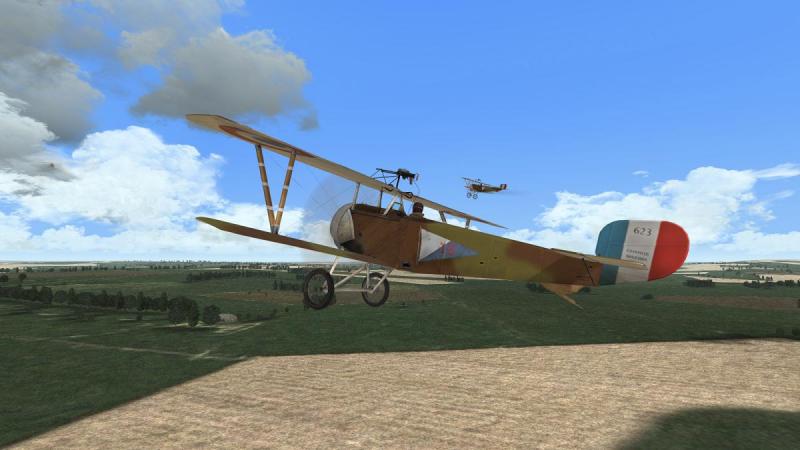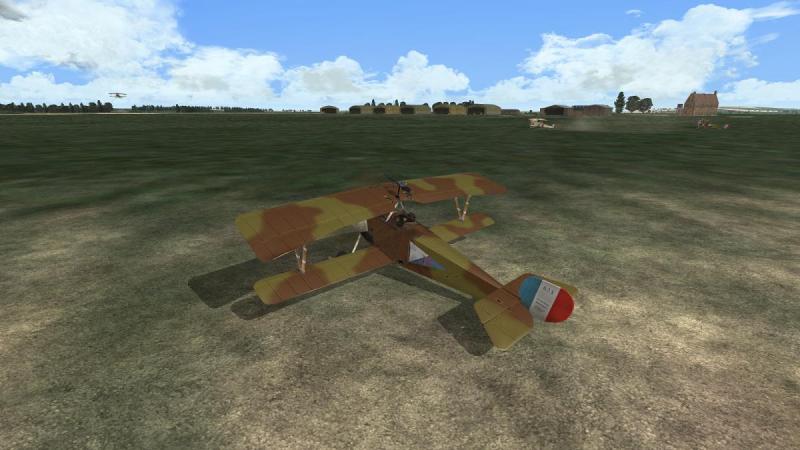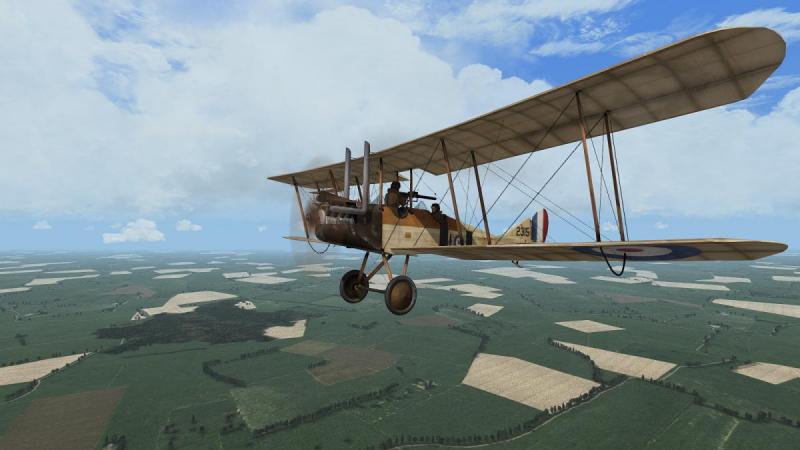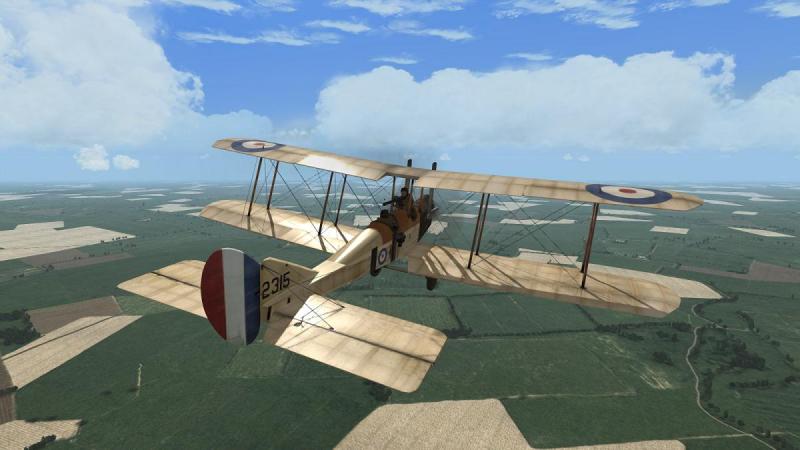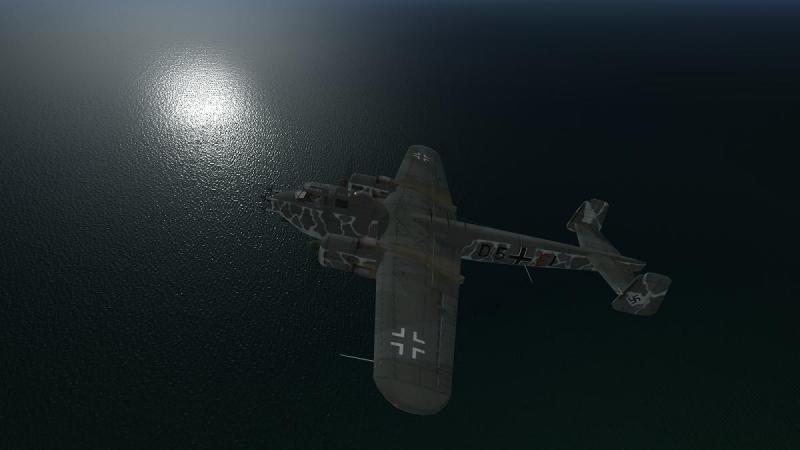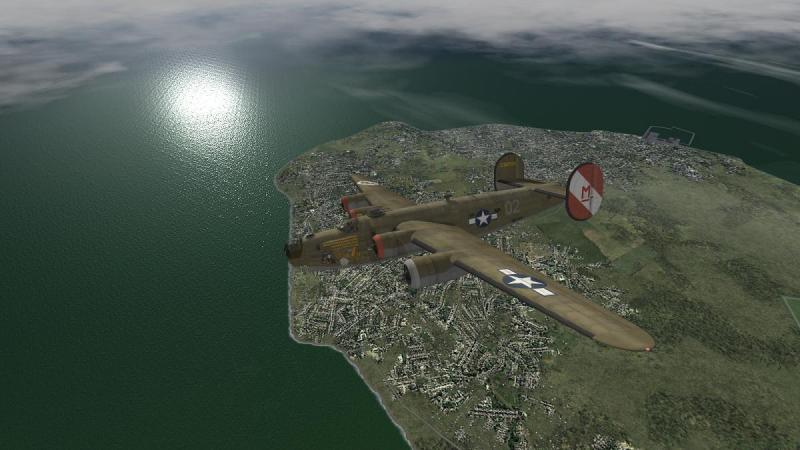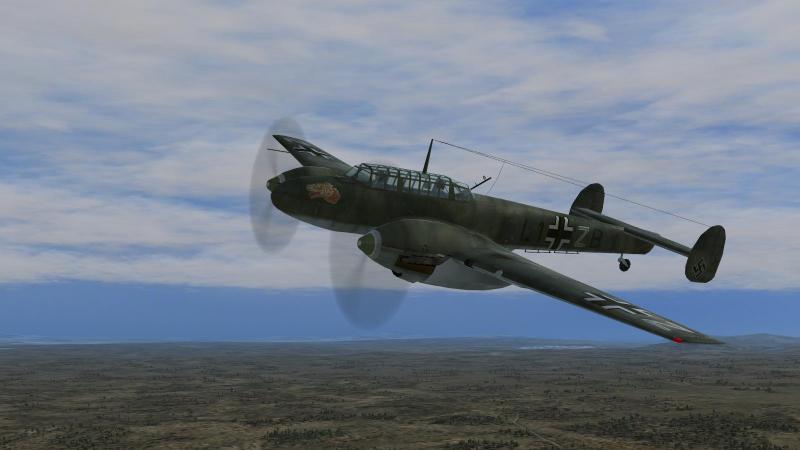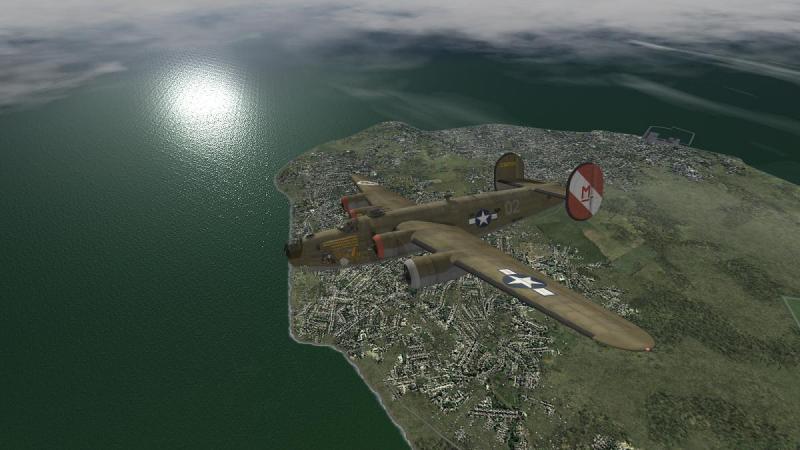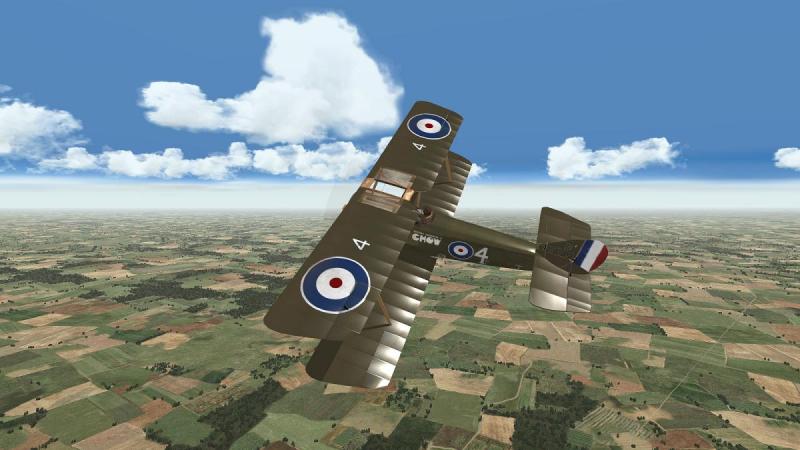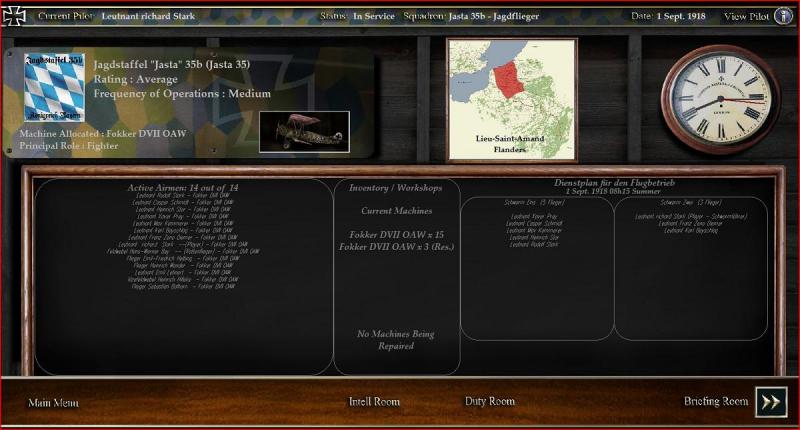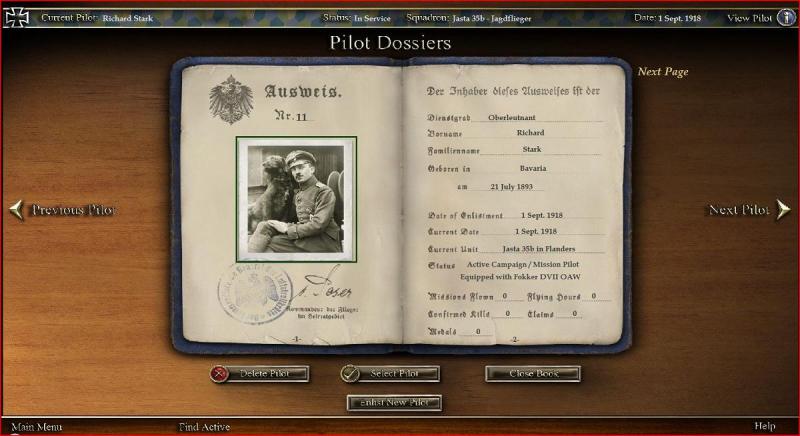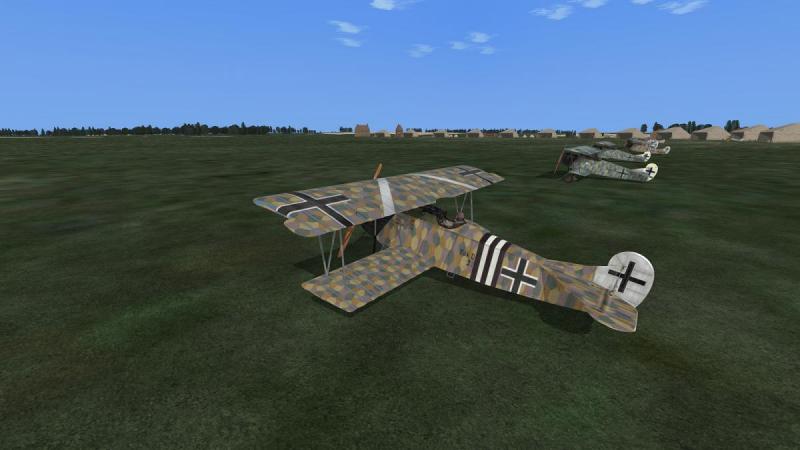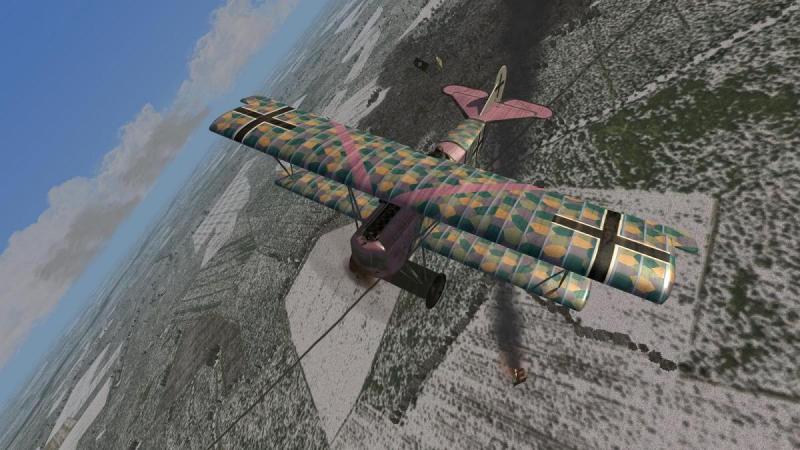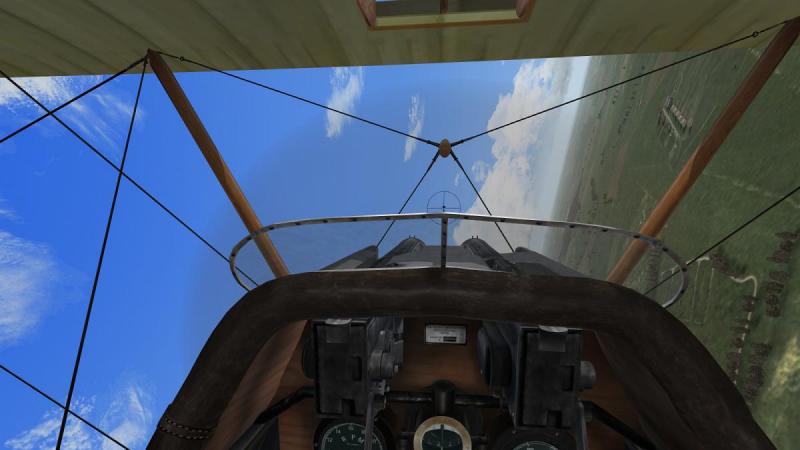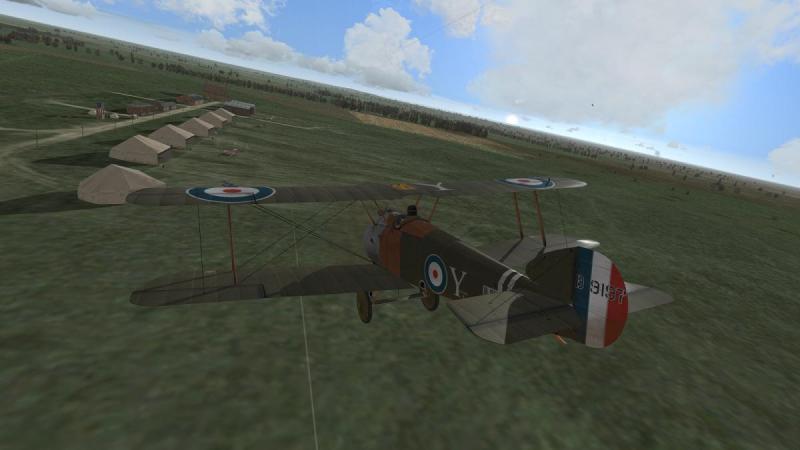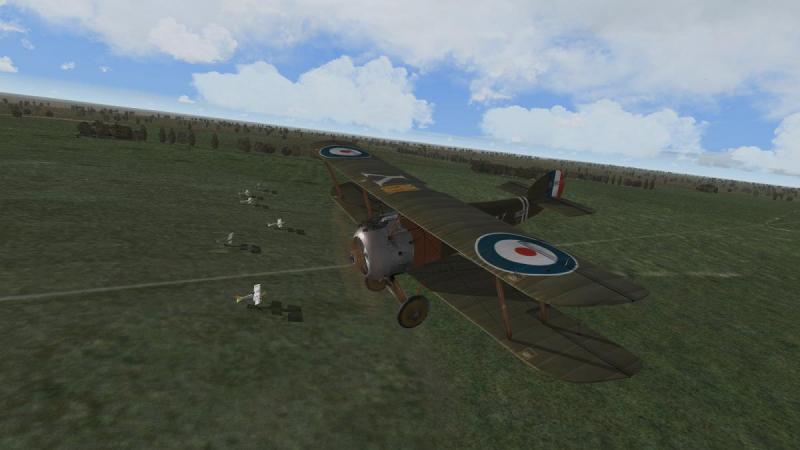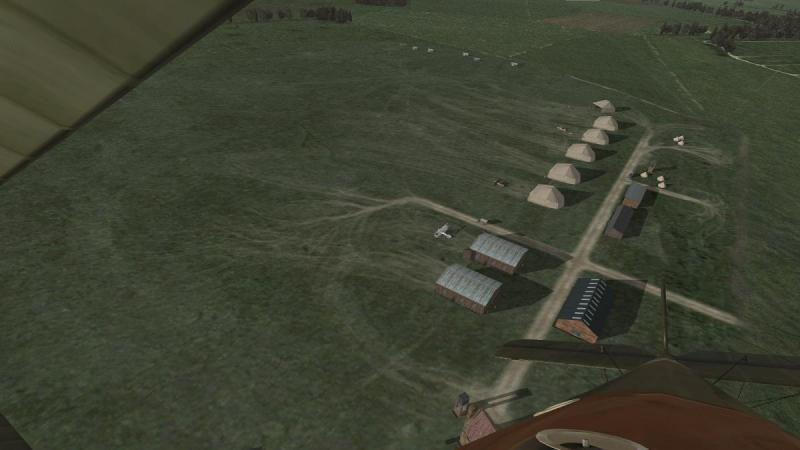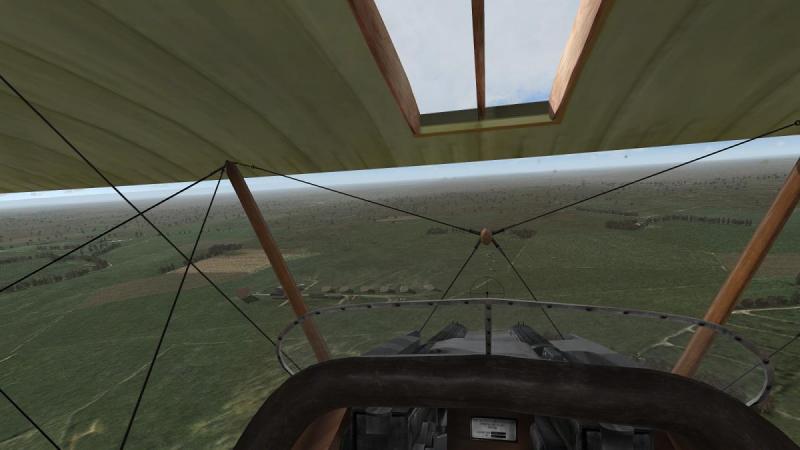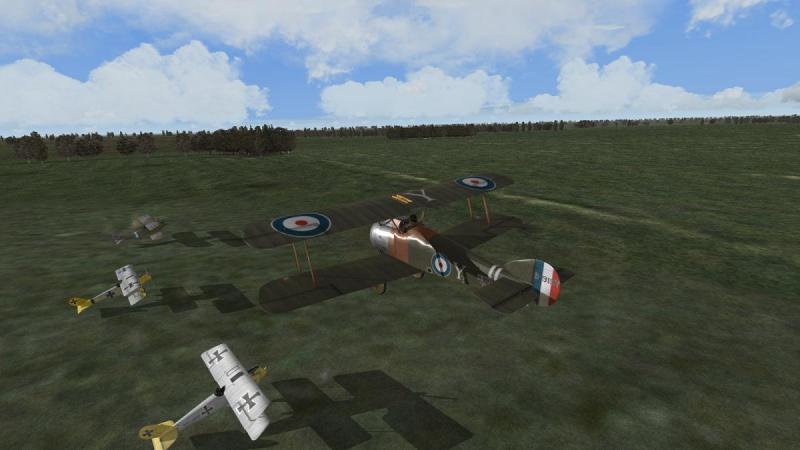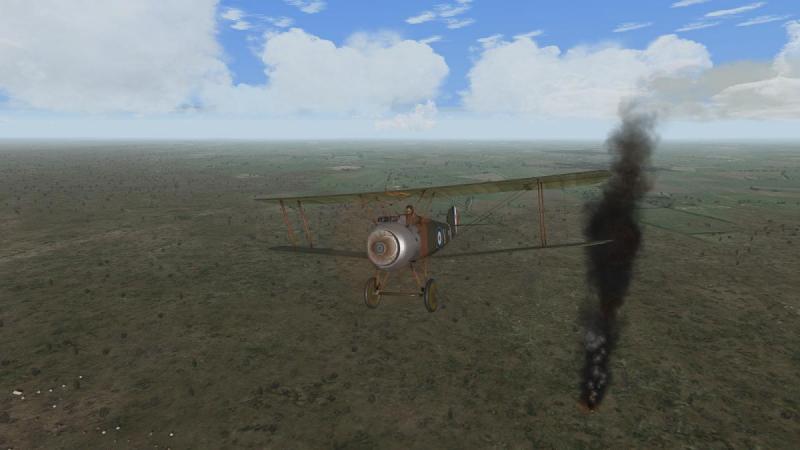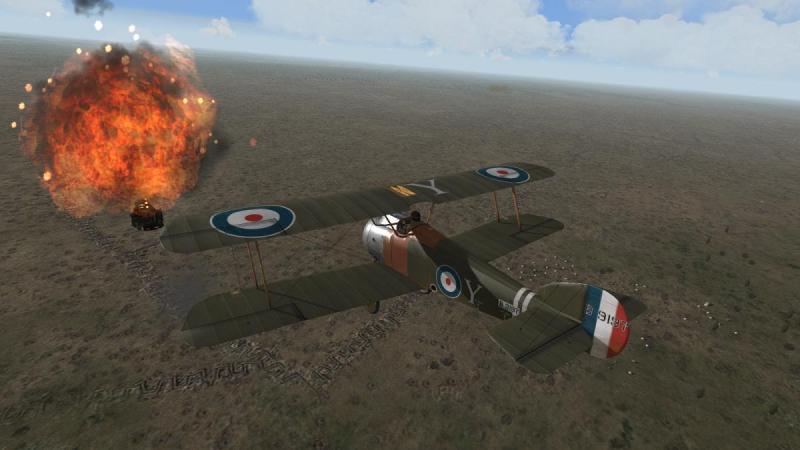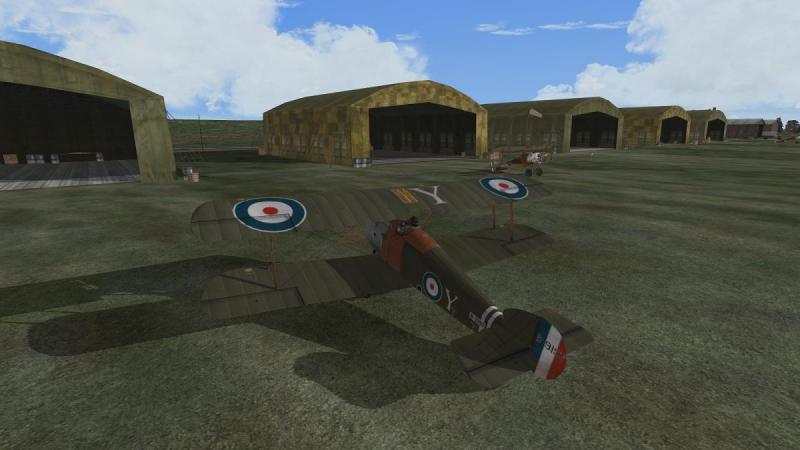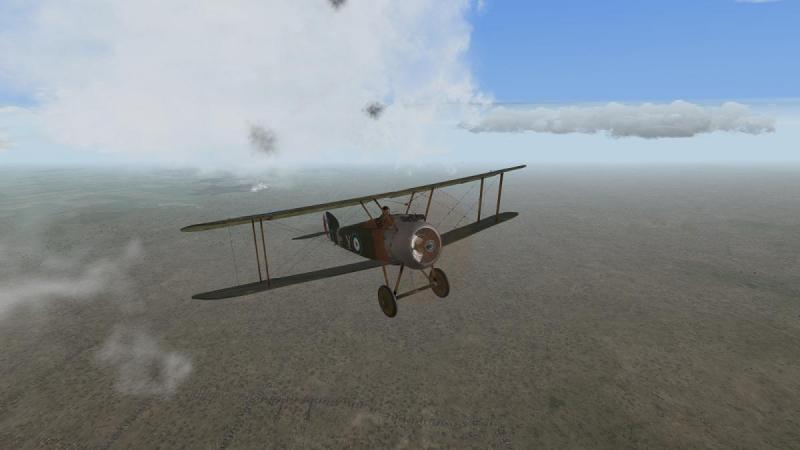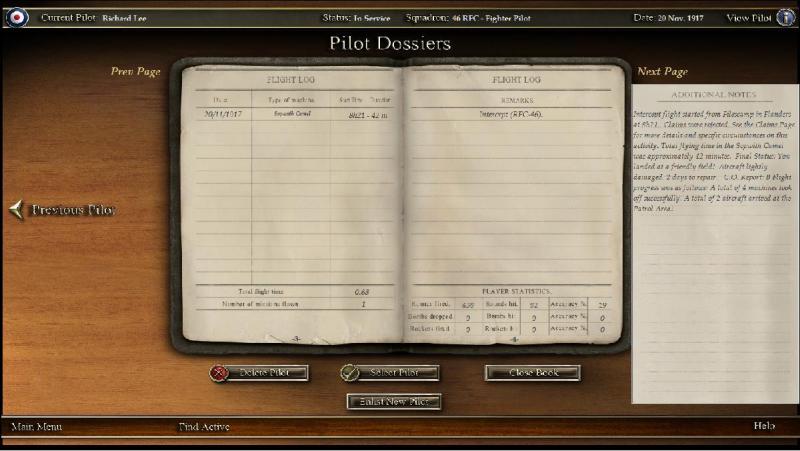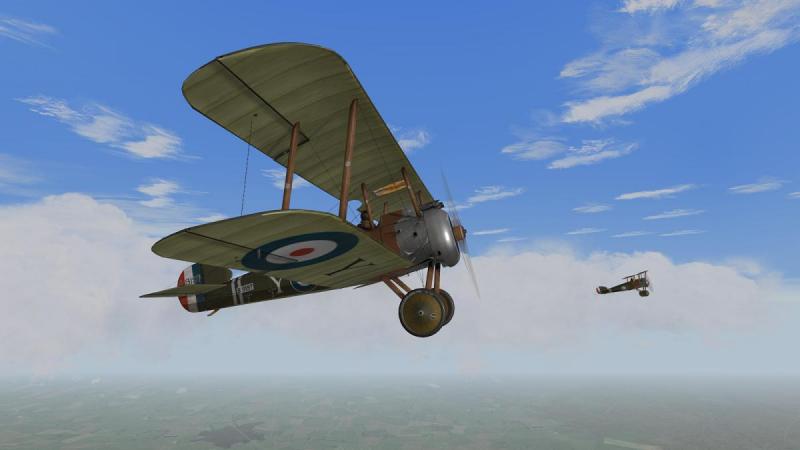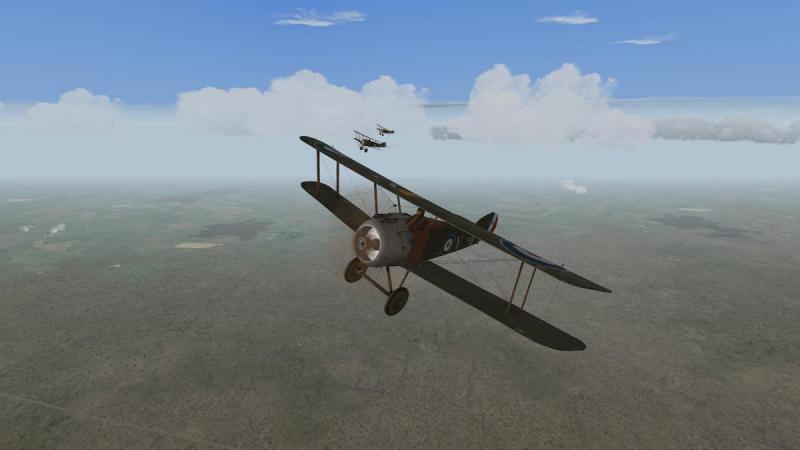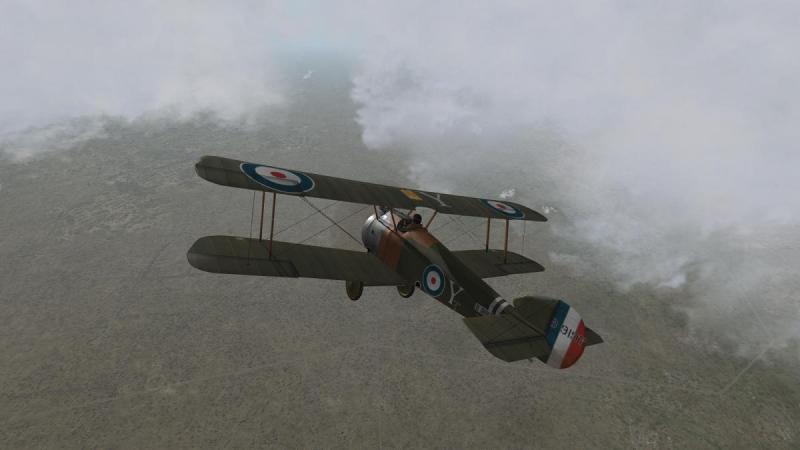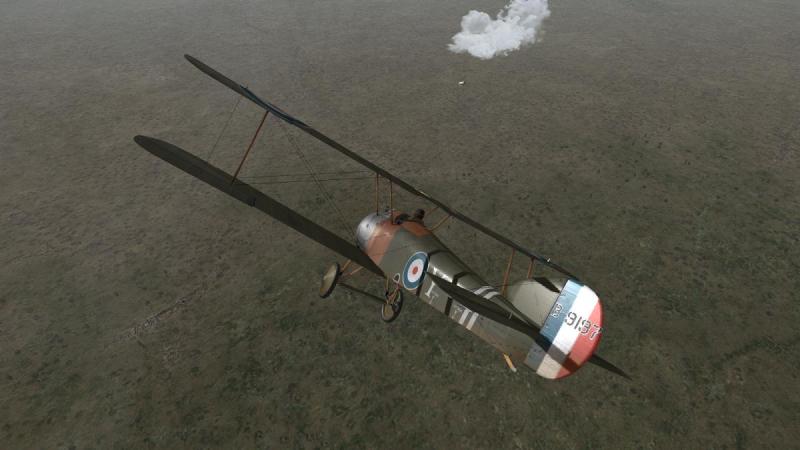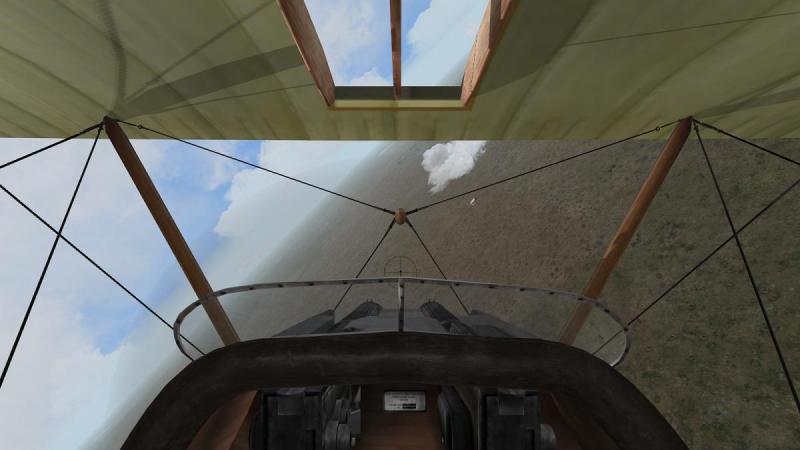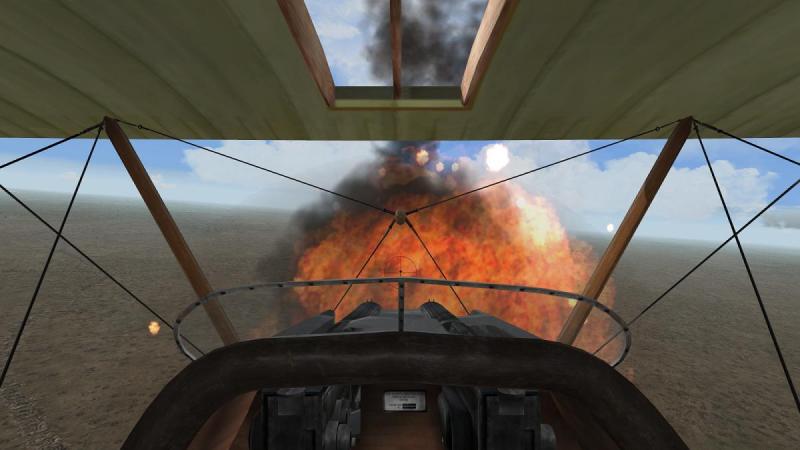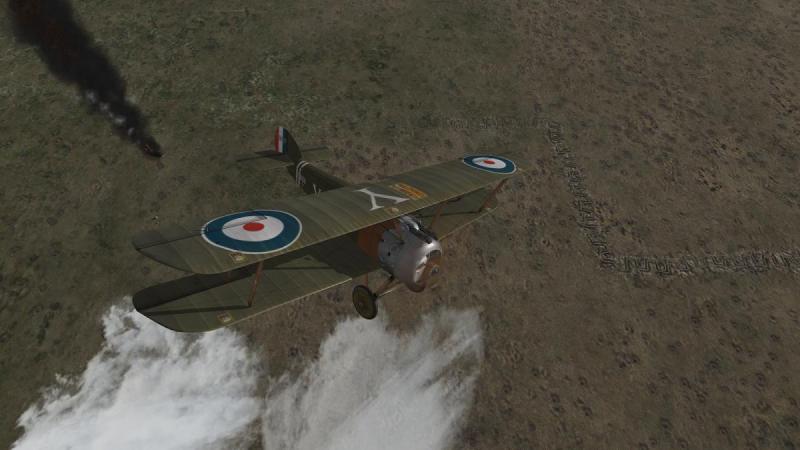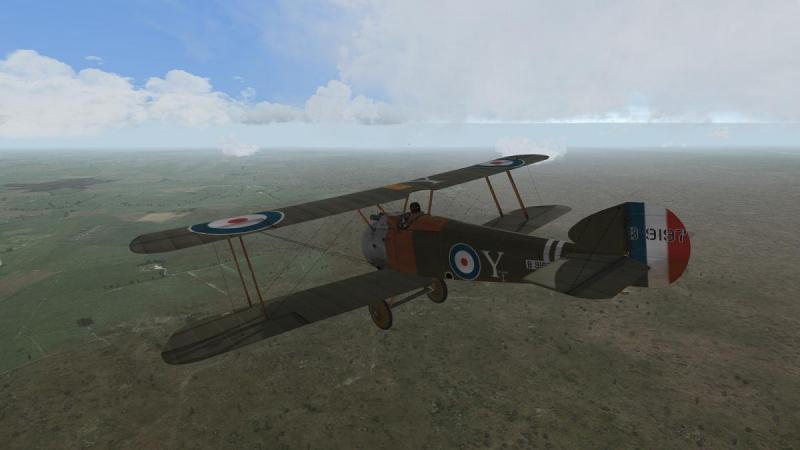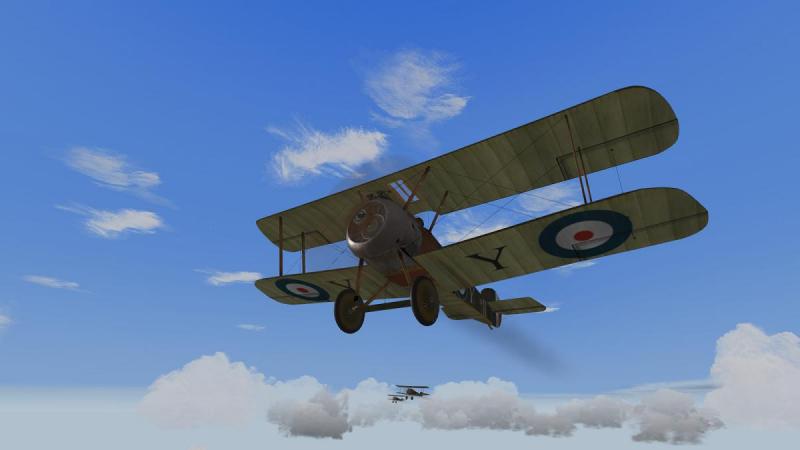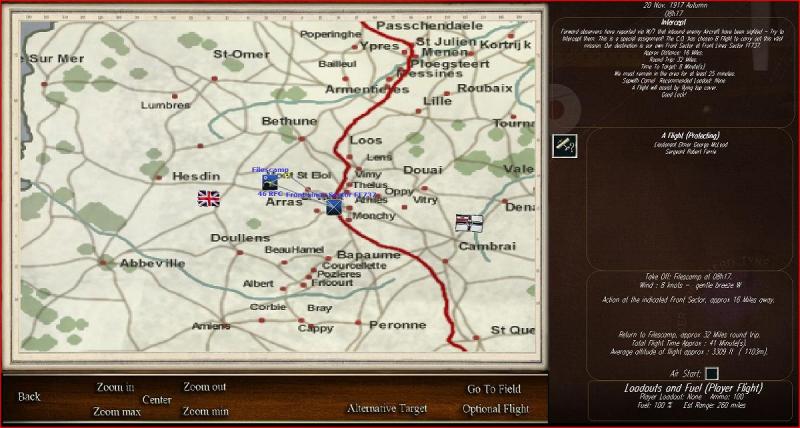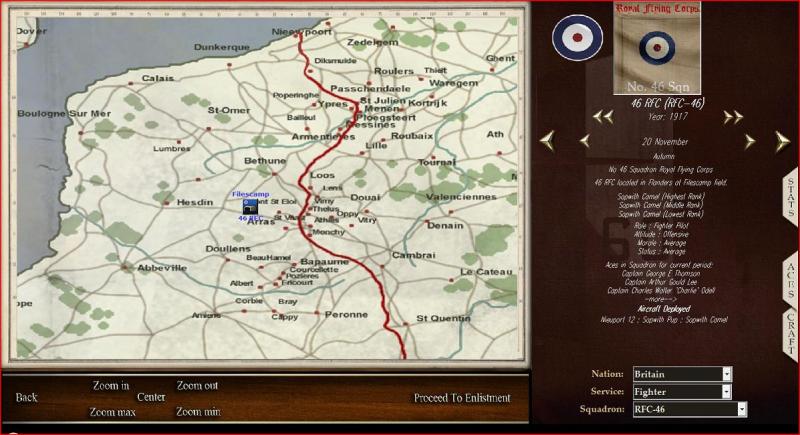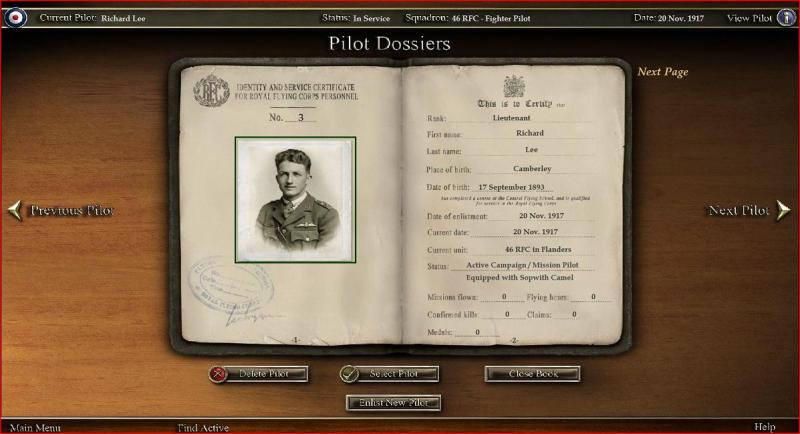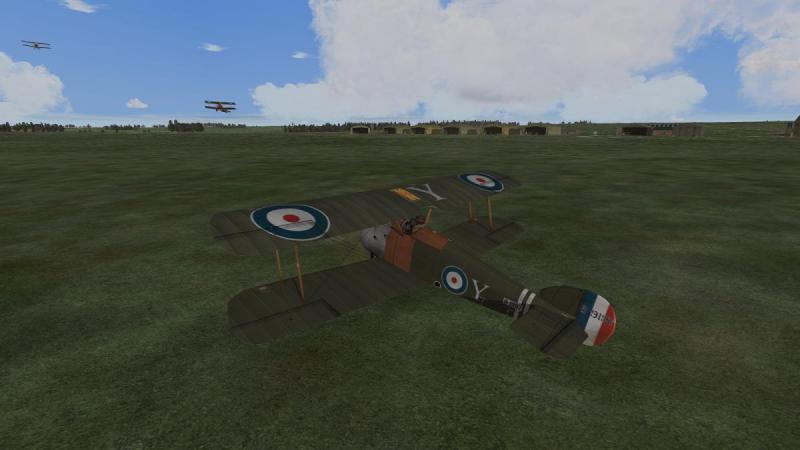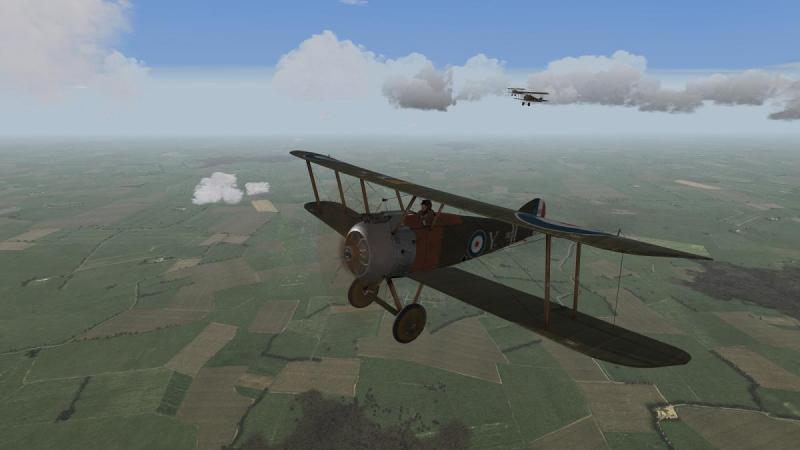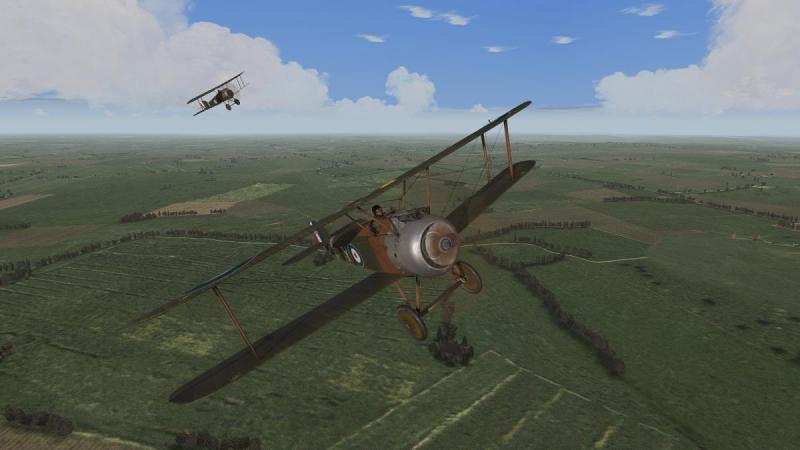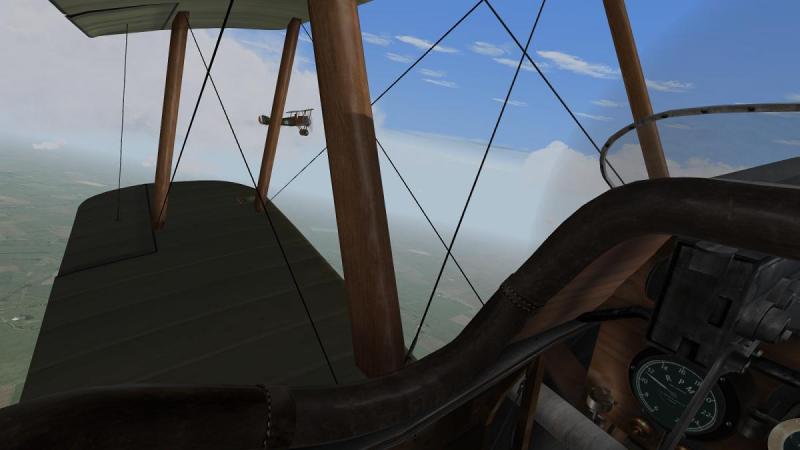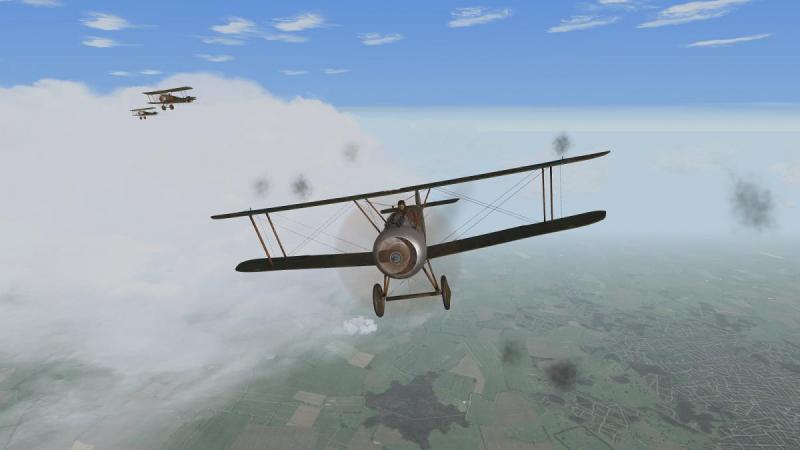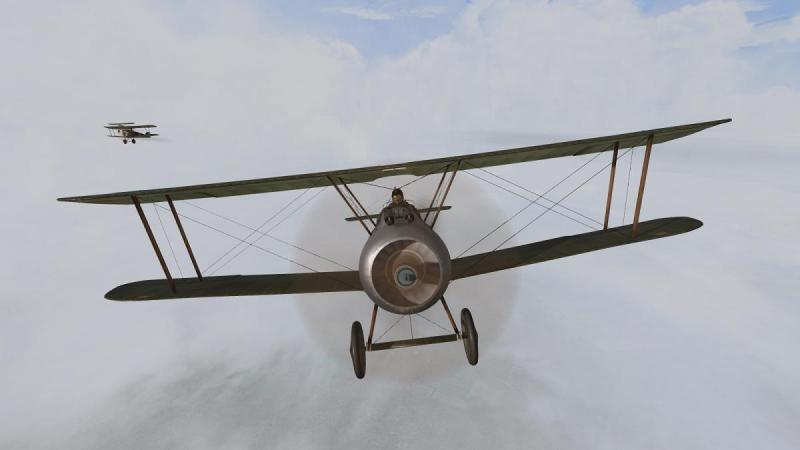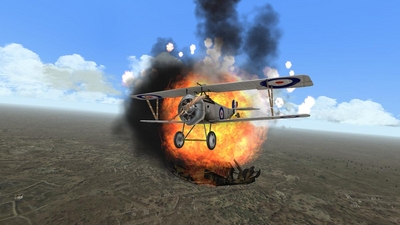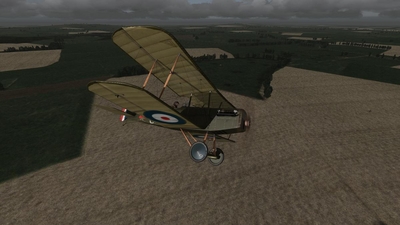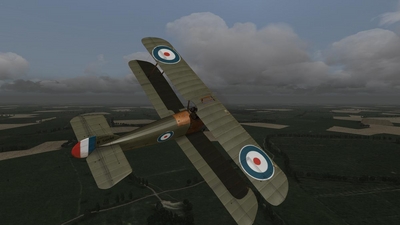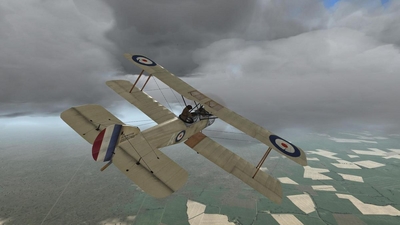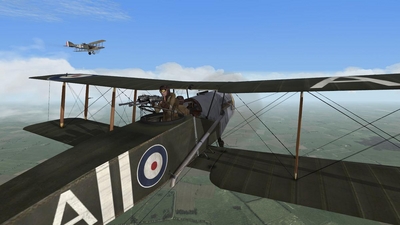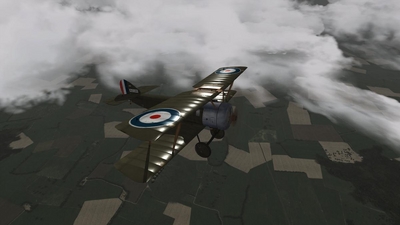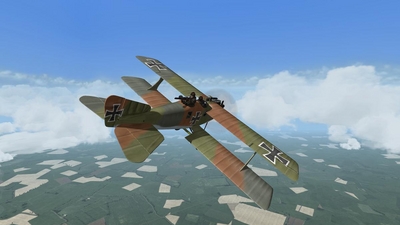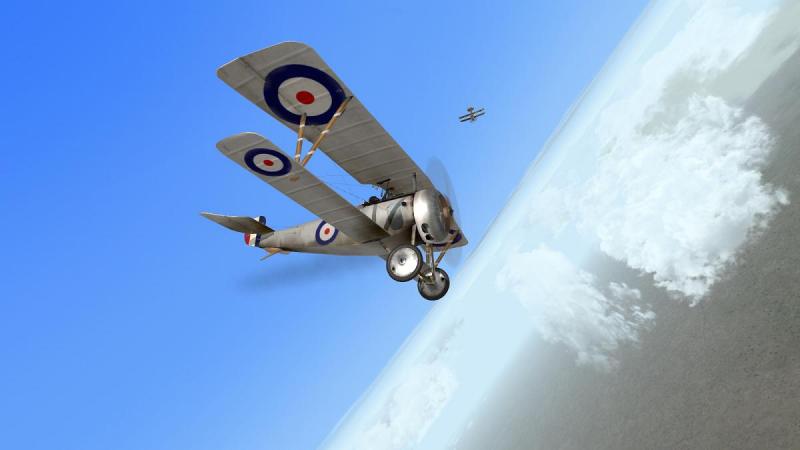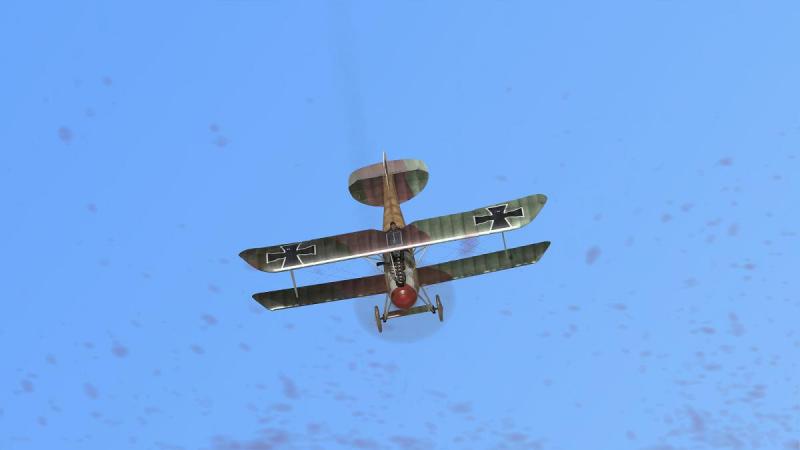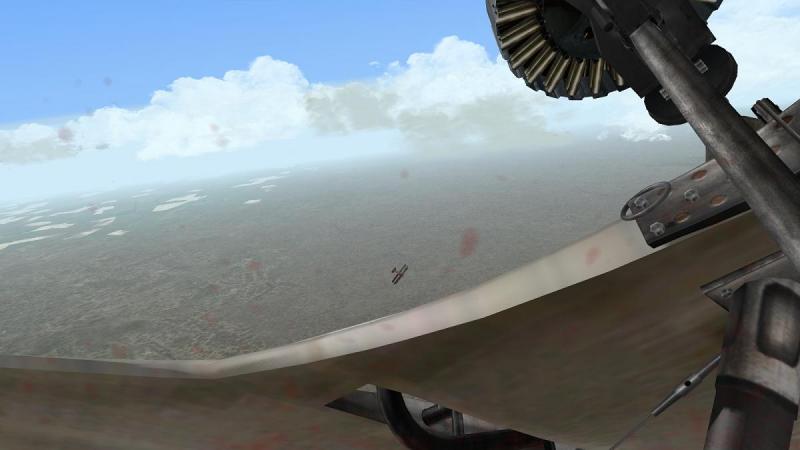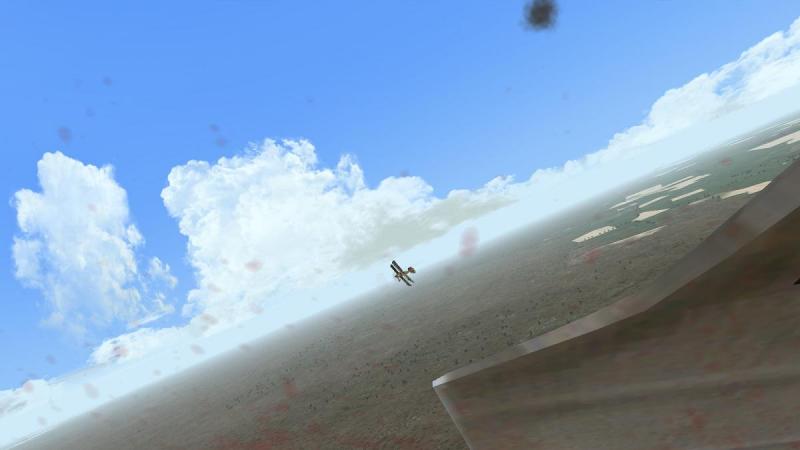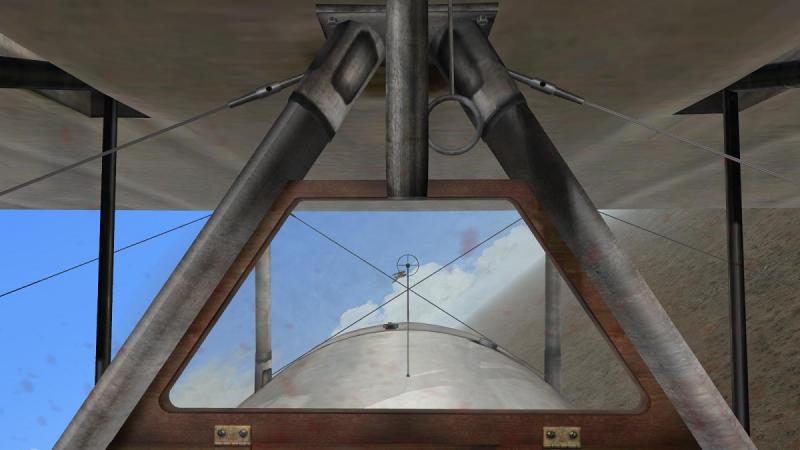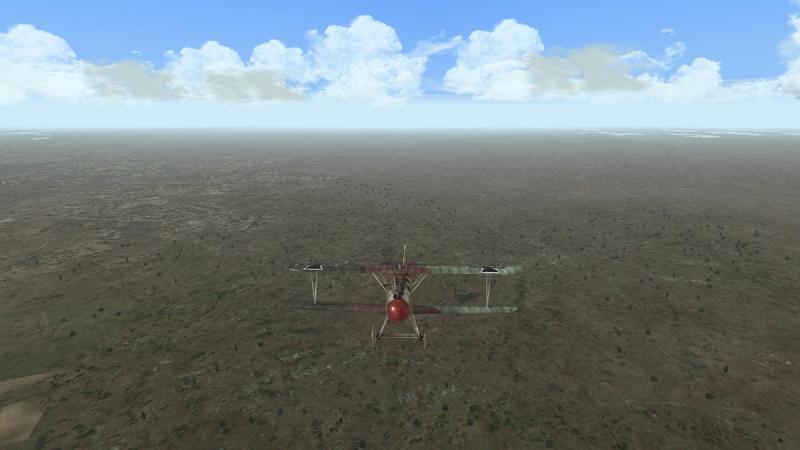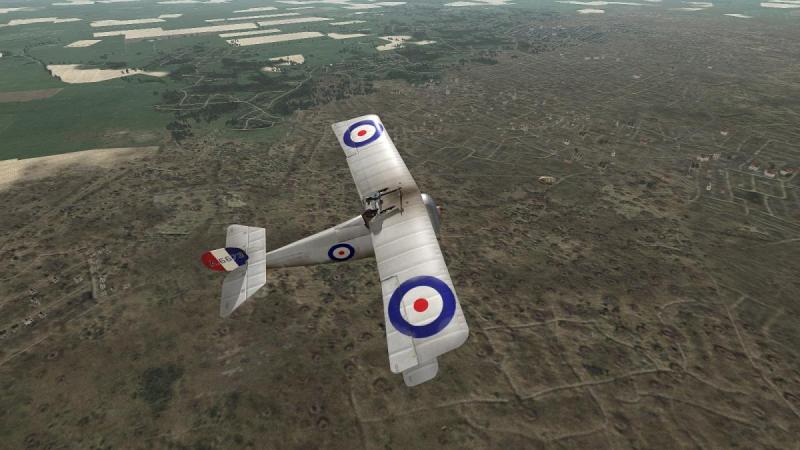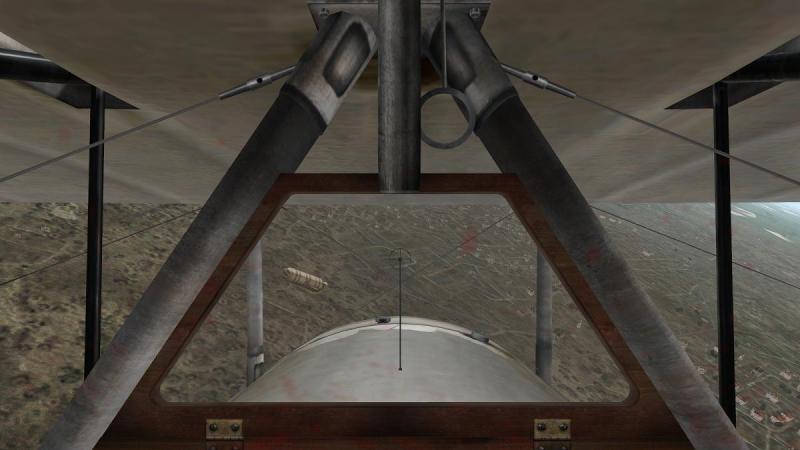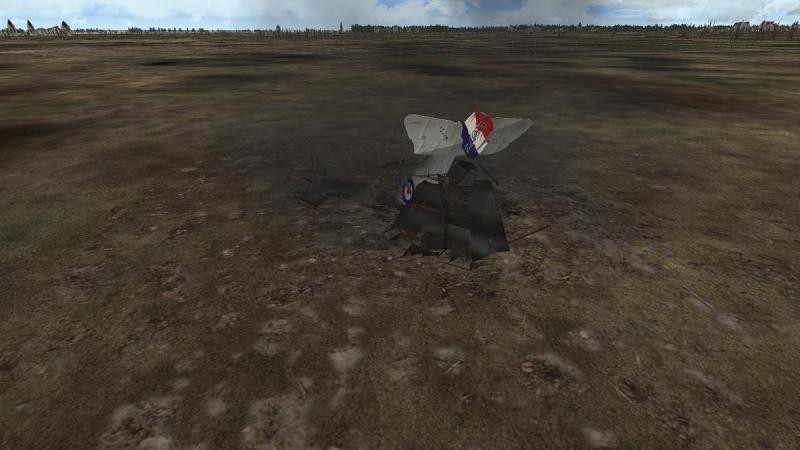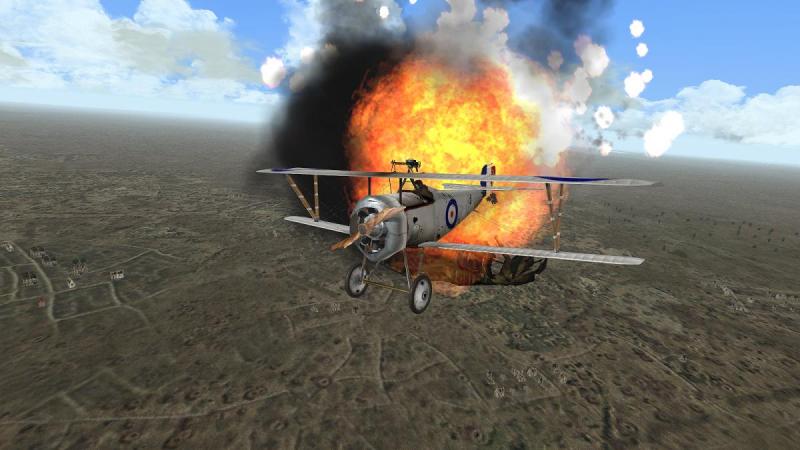-
Posts
3,749 -
Joined
-
Last visited
-
Days Won
7
Content Type
Profiles
Forums
Gallery
Downloads
Store
Everything posted by 33LIMA
-
The other nationalities in Wings Over Flanders Fields Part 1 - the French air service I can't do a biography-based mission report for the US and French sides as I only have memoirs by British and German pilots. But for the sake of completeness, I'm going to do a separate pair of mission reports in Wings Over Flanders Fields, one flying for the Aéronautique Militaire, the other for the US Army Air Service. First up, it's the French service, flying the little Nieuport 11, aptly nicknamed the bébé (baby). The plane Oddly enough, pre-war Nieuport designs were monoplanes. Their first biplane was the two-seat Nieuport 10 of 1915, which set the pattern for the aircraft which were to follow: biplanes with a much smaller lower wing, joined to the upper one with a V-shaped interplane strut. These were intended from the start to be armed. The early Nieuport 10 AV had the observer in front ('en avant', hence AV) with a circular cut-out in the upper wing, to enable him to stand up and fire a carbine or a Hotchkiss machine-gun pintle-mounted on the wing in front. But the later Nieuport 10 AR, and the more powerful Nieuport 12 which followed, moved the observer to the rear ('en arriere', hence AR) where he manned a Lewis Gun on a moveable or rotating mount. The Nieuport 10 AV During 1915, some Nieuport 10s were flown as fighters on patrols, with a Lewis Gun fixed above the upper wing to fire ahead, high enough to miss the propeller arc. Their success inspired the Nieuport 11, a smaller, nimbler development. This was arguably the first real fighter aircraft; genuinely capable of air-to-air combat in a way the inferior Fokker monoplanes were not - the latter being interceptors rather than fighters, with a synchronised gun but primitive wing-warping roll control and generally not well-suited to dog-fighting. In the hands of France's emerging aces like Georges Guynemer and Jean Navarre, the Nieuport 11 was instrumental by early 1916 in reversing the German's brief period of ascendancy in the air, 'the Fokker Scourge'. The British contribution was the DH-2, but while also better than the Fokker, this 'pusher' design was a technological blind alley. By contrast the Nieuport 11 proved capable of significant further development. Later versions, the Nieuport 16, 17, 23, 24 and 27, were widely used by both French and British, and later by the US Escadrille Layfayette. RFC aces like Albert Ball and Billy Bishop also rose to prominence flying Nieuport Scouts. The type was widely used by Italian and Russian air forces as well as on the Western Front, despite a continuing and alarming tendency to failures of the weak lower wing, often killing the pilot. All in all, the Nieuport V-strutters were one of the war's classic designs, inspiring the layout of the German Albatros D III which from early 1917, largely swung the air superiority pendulum back towards the Germans. Recommended reading on Nieuport aircraft would include Crowood's 'Nieuport Aircraft of WW1' by Ray Sanger and Osprey's 'Nieuport Aces of WW1' by Norman Franks. The unit For this mission, I created a new French pilot and assigned him to Escadrille N.12 (the French gave squadron numbers a leading alphabetic designator which - though a change could sometimes lag behind a change of aircraft - indicated the principal type of aircraft flown - 'N' for Nieuport, Spa for SPAD, for example). The unit had a long and worthy combat history. There's a great online source here; even if you speak no French, the illustrations, maps and tabular information tell their own story. The unit marking was a blue and while 'fanion' or guidon with the number '12', usually in red, carried on the side of the fuselage. As you can see, it's 1 May 1916 and we are based at La Cense, near Compiegne. Happily, we are close enough to La Belle Paris for us to have some interesting and diverting 'R and R', on our days off. But that's a very different kind of mission with quite distinct objectives! The mission Here's the brief for today's mission, which takes us well away from the delights of Paris. It's a patrol along a dog-leg route, up to the trench lines, which are not too far away. I'm leading a flight of three; a second flight of two aircraft is also flying the mission, as 'top cover'. Our briefed mission height is 10,000 feet. Starting on the grass in front of the sheds at La Cense, I waited till the first couple of machines had roared off then sped after them. All of us were in green and brown 'shadow shading' camouflage, apart from one fellow who was in clear doped linen, with prominent blue, white and red chevrons on his fuselage. This was the aircraft of squadron ace Lt Pierre Dufaur de Gavardine, said in the Osprey aces book to have scored six victories with the unit, before being badly wounded early in 1917. I was quickly off the ground and climbing steadily. With the front just a short distance away, I hoped to meet the Boche in the air before very much longer and perhaps indulge the superiority of my neat little aircraft, at the expense of some inferior Fokkers, Aviatiks or the like. Would my hopes be realised or dashed? I would find out in good time. ...to be continued!
-
This any better?
-
PS - as of Patch 1.24, the WOFF 3d models for the BE2c and BE2c 'early' have been improved, now featuring corrected rigging and other changes, resulting in a significantly more accurate appearance for this important type:
- 3 replies
-
- wings over flanders fields
- woff
-
(and 1 more)
Tagged with:
-

JSGME enable mod for custom UI.XML file for WOFF
33LIMA replied to rjw's topic in WOFF UE/PE - General Discussion
Thanks Robert. If I read this right, I see you changed the dot mode only label colour to red (for enemies anyway). Did you discover a method to change it (back to) black or to dark grey? I'd prefer this as (i) it's likely less visible when seen thru your own airframe (ii) I don't mind the dots being hard to see against the ground, but for realistic appearance and better visibility, I would much prefer to see the dots dark (dark grey or even 'back to black') against the sky. -

Does AnKor's mod work on OFF?
33LIMA replied to UK_Widowmaker's topic in WOFF UE/PE - General Discussion
For some reason it didn't work in OFF for me either, at first, with exactly the same symptom, despite reports at Sim Outhouse that it worked with OFF and stock CFS3. But I had to replace my graphics card - a GTS 250 for an 8800GT - and then it worked. Apparently you need to re-run CFS3.config and reset the screen resolution even if it looks right. Maybe also delete any driver profile for the OFF CFS3.exe in case there's some incompatibility somewhere that's not universal. But despite the GTS 250 being apparently from the same family as the 8800GT/9800GT and not updating drivers with the graphics card change, the mod now works fine in OFF and cFS3, where before it worked for me only in WOFF. Some weirdness at work, there. -
PS - CFS3 ETO Expansion now looks even better, thanks to Ankor's DX9 mod, which adds dynamic self-shadowing to aircraft and reflective water textures and works with conventional or modded CFS3 installations, as well as OFF and WOFF: ...and the Bf 110 featured in this mission report, in the latest (July 2016) version of Ankor's mod - no more fishe-eye lens external view: Available here.
- 9 replies
-
- 1
-

-
- cfs3
- eto expansion
-
(and 1 more)
Tagged with:
-

Does AnKor's mod work on OFF?
33LIMA replied to UK_Widowmaker's topic in WOFF UE/PE - General Discussion
-
Decisions, decisions! I was soon joined by my two flight-mates, in the 'vee' formation I had selected in the 'loadout' screen'. I opened her wide and we began the climb towards the rendez-vous point with the two reconnaisance machines. Before too long, I was relieved to see them ahead. Hannovers are not the fastest of aeroplanes and I was able to overhaul them while still climbing. Soon, I was closing on them steadily, from above and behind. At that point, I noticed a cluster of dark specks appear in the sky, about half right and slightly higher, some way off. As I watched, I realised these were German flak bursts. This didn't look good. If their targets were fighters, they were clearly a potential threat to my charges. I continued to shadow the Hannovers, but began a new climb, so as not to be caught at a height disadvantage by the incoming enemy aircraft, whoever they might be. The cluster of flak bursts was slowly drifting left to right, and I was hopeful that they would eventually pass well astern. At this point, however, the Hannovers well and truly put the proverbial cat amongst the pigeons. They began a steady 180 degree turn to the right, taking them back in the direction of the unseen enemy flight which was the target of that AA fire. I shook my head at their foolishness, then began a turn after them, easing off my rate of climb. The flak seemed to slacken off for a while but then broke out afresh. now slightly right and low....and much closer. I still could not see the targets, even against the clear blue sky, but they were now so close that a clash appeared imminent. As I turned into the patch of sky just ahead and above the flak bursts, it disgorged a shower of aircraft - five or six. Sopwih Camels, from the straight upper wing and dihedral on the lower one. Their formation burst like a starshelll and they came at us from several directions. I picked out the nearest and issued a hasty command to attack, even as I attempted a rapid turn to get around and onto the tail of my chosen Camel as he flashed past behind us. My intended target was hard on the heels of one of my flight. All the more reason to get after him! But in my haste, I tried to turn too tighttly while still climbing and I spun out. I should have put the nose down or at least levelled off, as I turned. I lost ground, but recovered quickly from the spin and was soon after the Camel again. He, too had lost height ,in pursuit of my comrade who was turning desperately to get away. I got in a good burst, which seemed to cause the Camel to stagger then spin, down and out of the fight. I cleared my tail and turned to stay above him, watching to see if he recovered. He did. By this time, I was well below the rest of the fight. Now, I had a decision to make. Should I climb up to rejoin the main battle? Or was it better to go after the Englishman down below, in the hope of getting the first victory of my career with Jasta 35? In retrospect the right answer was to climb up and rejoin the fight. I had saved a flight-mate and driven a Camel down from the battle, so evening the odds. By rejoining my comrades above I could have helped them defeat the remaining Englishmen. But I had lost sight of the others, and was reluctant to leave the one opponent I could see. So I dived down after the Camel, noticing that he was now flying straight and level for home. I was soon on his tail. A quick look around me revealed nothing. The Camel turned right as my first burst seemed to go straight into him. I also turned right, managing to keep pace with the likely-damaged or wounded enemy, despite the rotary-engined Camel's reputation for a right turn that few other aircraft could follow. Suddenly, a burst of MG fire whacked into me from somewhere unseen. Blood spattered my goggles...my blood. Cursing my stupidity at being caught thus, I broke hard, but my machine answered the controls only sluggishly. The reason wasn't hard to see. My lower left wingtip was in tatters. My attacker was the Camel which you can see on the right of the screenie below. By the look of it, he'd clobbered me with a deflection shot from somewhere ahead but out of sight. As I fought for control of my damaged Fokker, out of the corner of my eye I saw an impact in a field to my right. It was some consolation that the Camel I had attacked had crashed - you can see the grey burst of smoke from this to the lower left of the picture. But it looked like I would be the next man down. Even as the last of the German flak bursts aimed at the Camel I'd shot down faded, I banked around towards what I hoped was a suitable field for a forced landing. Somehow I managed to keep my wings level, plonked my Fokker down onto the grass and switched off the motor. By some miracle, she didn't roll over or cartwheel to destruction. To my right as I trundled to a halt, my victim burned in a nearby field. Above, my conqueror wheeled around and then headed off towards the Lines and home. As it happened, he was from No. 4 Squadron, Australian Flying Corps, so at least I'd been shot down by a pilot from a pretty illustrious unit, famous not least for an air fight the following month when, greatly outnumbered but flying the new Sopwith Snipe (also featured in WOFF) they reportedly claimed ten Fokkers downed for just one loss. And that was the end of my mission. It was in fact also the end of my career. The debrief - despite permitting me to make out a claim for my victory, which I did - informed me that I had died of my injuries. There are many cases on record of a badly-injured pilot making a forced landing but not recovering from their wounds, so while disappointing, this was not unusual. As so many likely did, I paid a high price for making a bad decision, in this case, going after a Camel who was out of the fight instead of rejoining my comrades. Nevertheless, the mission was a telling and convincing recreation of the battles depicted by Rudolph Stark in 'Wings of War', brought back to life in Wings Over Flanders Fields, whose superb single-player campaign system and great new AI and visuals make it so very well suited to such endeavours. That completes this particular series of mission reports, though others like them will doubtless follow. I hope you enjoyed reading the reports as much as I enjoyed flying the missions, however they ended! For now, keep your eyes open for the announcement for the CombatAce Wings Over Flanders Fields competition, which will be posted by Skyviper soon. Good hunting...or should I say, hals und beinbruch!
- 2 replies
-
- woff
- wings over flanders fields
-
(and 1 more)
Tagged with:
-
Flying the famous Fokker D VII in another WOFF campaign mission inspired by a World War One classic! The man and the book I believe Rudolph Stark's 'Wings of War' was first published, in English at any rate, in 1933. It was translated by Claude W Sykes, described by Norman Franks as 'among the better aviation writers of the period' in his introduction to a recent reprint of Sykes's 'German War Birds', written under the pen-name 'Vigilant' and one of my favourite WW1 air war books from my younger days. 'Wings of War' starts during 1917 with Stark a two-seater pilot, yearning to transfer to single-seater 'scouts', as fighters were commonly called in those days. His transfer comes through and he receives his fighter pilot training at Jastaschule 2 at Saultain, near Valenciennes in occupied France. There's little said about this period; he completes his training just before Christmas 1917 and the book really begins with his posting to the Bavarian Jasta 34 at Chenois, flying against the French, not far from where his two-seater unit was based. Stark flies a sleek Pfalz D III, his lilac personal colours being painted on top of the type's distinctive silver-doped factory finish. His first air combat in single-seaters is nearly his last. With two others, they attack a twin-engined Caudron but a French fighter loops onto Stark's tail and riddles his Pfalz, holing the petrol tank. Stark is lucky to escape after an involuntary spin earthwards. Racing for home, seemingly pursued by further gunfire, he lands to realise the rattling behind him is his seat-belt buckle flapping against the fuselage, the belt having been parted by a French bullet. In March 1918, Jasta 34 moves north, to Le Cateau, to participate in the German spring offensive against the British. This was designed to win a decisive victory on the Western front, using troops freed up by the collapse of Imperial Russia and the truce with the Soviets, before the arrival of substantial US forces in France swung the balance of forces irreversibly against Imperial Germany. The fighing is intense and Stark, still apparently flying the Pfalz, claims his first victory in late March, a British two-seater. In May, Stark is made temporary leader of Jasta 77, based at the same airfield, and in June, he is appointed to command another Bavarian jagdstaffel, Jasta 35, in the Cambrai area. By August, their attacks having stalled, the Germans are facing a British counter-offensive and Jasta 35 is pleased to receive its first Fokker D VIIs, as replacements for some some of its older aircraft. Supplies of the superb new German fighter are limited, though, and in September, the staffel is compelled to accept instead some more machines from Bavarian manufacturers, the Pfalz D XII, to the disappointment of those pilots who don't get Fokkers. It is all to no avail. Driven back on the ground and outnumbered in the air, the Germans are clearly losing the war. Falling back as the front is pushed east, Jasta 34 fights on, to the Armistice in November, bombed on the ground and harried in the skies above. While Stark's book covers just the last year of the war, he had an interesting and eventful time of it, flying in combat the Fokker Dr I triplane as well as the Fokker D VII and the Pfalz D III. His combat memoir is a vivid one with rather more detail on places, units and planes than you tend to get in a wartime account. In fact, most printed descriptions of the Pfalz D XII rely heavily on Stark's quoted views of the type. 'Wings of War' (mine is the 1973 Arms & Armour Press edition) also benefits from the inclusion amongst its illustrations of reproductions of several of the author's own paintings, depicting some of his fights in the air. Highly recommended. The air war in autumn 1918 By this point in the war, German fortunes were in terminal decline. In an effort to contest the increasing numerical and technical superiority of enemy fighters such as the SPAD XIII, the Camel, the SE5a and the newer Dolphin, the Germans had, in early and mid-1918, held competitive trials for fighter prototypes from many manufacturers, with frontline pilots participating in the evaluations. Anthony Fokker's entry to the trials was his company's V11, which, with a fuselage lengthened to solve initial handling problems, was the star of the show in the early trials. It was ordered into production as the Fokker D VII, regarded by many as the best German fighter of the war and a worthy match for anything in the enemy camp, with its responsive controls and relatively viceless handling. But many units had to soldier on with obsolescent Albatros and Pfalz scouts, against stronger enemy air arms which now included the RAF's 'Independent Force' carrying out 'strategic' day and night bombing and the first units of the United States Army Air Service, flying first the elegant Nieuport 28 but by the end of the summer, transitioning to the often-unreliable but sturdier SPAD XIII. The mission Here's my pilot for this campaign mission, evidently a family member of the author! I've started him off in September 1918, because this is the month from which the unit, in WOFF, is fully equipped with the plane I wanted to fly, the Fokker DVII. Previously, the staffel was said by Rudolph Stark to be flying a mix of the Allbatros DV, the Pfalz D III and (tho not featured in WOFF) unspecified Rolands. And here's Jasta 35's line-up for the campaign. I'm starting off in the second flight, with myself and two other pilots. The author himself is in the first flight. As their designation indicates, our Fokkers are made under licence by the Ostdeutsche Albatros Werke (OAW). Despite the late stage of the war, we seem to have plenty of both aircraft and pilots. At this point, we're based at Lieu St. Amand, just north of Cambrai, in Flanders. Here's our briefing for the first mission. The full staffel is turning out to protect a pair of Hannover CL IIIs on a medium-level reconnaisance mission, down to the sourh-west, to an objective just the far side of the trench lines. The first flight is described as flying top cover so I'll be taking on the role of close (or closer) escort for the two-seaters. Here we are, both flights lined up on the airfield and good to go. In the briefing stage, you have the opportunity to pick a 'skin' for your plane and here, from those available, I'd chosen that of Xaver Prey. I'm not sure if this skin comes with WOFF or OFF - I've experimentally copied over the skins from OFF to WOFF using Jonesoft's mod enabler pending purchase of the official WOFF skin pack. Anyhow, you can see from the line-up that there are variations in the 'lozenge' fabric covering of our machines, as there were in real life, but we all carry the Jasta 35b unit colours of a white chevron on the top of the upper wing and a black chevron underneath the lower one. My individual marking comprises the black and white bands you can see behind my cockpit, Rudolph Stark's machine had a lilac nose and fuselage band and a black-edged lilac tailplane. Off we went, into the clear blue September skies. This was my first campaign mission in WOFF during this late period of the war. Flying for the side which was just two months away from collapse, I was more than a little anxious as to what the next hour or so would bring. With good reason, as it turned out! ...to be continued!
- 2 replies
-
- woff
- wings over flanders fields
-
(and 1 more)
Tagged with:
-
Airfield attack! I rolled into a strafing run on the Hun airfield, lining myself up with the front of a row of canvas hangars, where I judged it likely there would be some aircraft parked. But all I could see was two or three Albatros scouts. I picked the nearest of these, a red-nosed job, and gave him a burst, hosing the furthest aircraft rather inaccurately as I pulled up. It was in the final stages of my pass that I realised that a line of objects along the near edge of the airfield was a better target - a long row of mostly silver Pfalz scouts. By now, I was taking some return fire from ground MGs. But this was too tempting a target to leave untouched. So I pulled up and around, swinging over to the east, so as to make a firing pass from east to west, that would see me heading in the direction of friendly territory as I came out of my firing run. I was not going to make a third pass; no point in over-doing it. I swept in and over the line of enemy aircraft, hopefully getting some hits but without visible results. Most of my rounds ended up being fired at the last in line, a green and mauve machine which looked like a two-seater, likely the squadron hack. If nothing else, I'd thumbed my nose at an airfield full of Huns! Off I went, back to the Lines, feeling reasonably satisfied with my day's work. But another opportunity now presented itself. There, to my right, was another balloon. It was practically on my way home so I quickly decided that I would pay him a little visit, too. This time Archie was wide awake and black bursts appeared all around, but it didn't much help the balloon, which was soon going down in flames like the first one, just a few minutes earlier. Pursued noisily but ineffectively by Archie, I maintained my course westwards and was soon back in friendly territory. The flight back to Filescamp was uneventful and I landed without mishap. I was presented with a claim form and filled it in claiming two baloons destroyed. This was rejected out of hand, likely as I'd got one balloon but the other had been a victim of his own AA fire. A tad frustrating, but I knew I was responsible for the destruction of two balloons - one way or another - and for a rather daring solo raid on a Hun airfield, confirmations or no confirmations. As Bruno Stachel was told after his unconfirmed first kill, 'Then you have the deep satisfaction of knowing you have served the Fatherland.' Coming next in CombatAce-WW1 - 'Wings of War' by Rudolph Stark
- 3 replies
-
- 2
-

-
- woff
- wings over flanders fields
-
(and 1 more)
Tagged with:
-
The party begins! Up and down the Lines we trailed. I descended to about five thousand feet, thinking that perhaps I might spot some low-flying Huns underneath us, who'd been invisible from higher up. I even took a detour several miles into Hunland as far as Douai, where there was a cluster of German aerodromes, hoping I might well see some aerial activity in that vicinity, and maybe surprise some Huns forming up or going home. No such luck, just the same result - empty skies with no other aircraft to be seen, friend or foe. Except for the balloon. At the southernmost limit of one of my trips down the Lines, I had noticed a German observation ballloon, quite low down on the edges of the shelled area, near a town I judged to be Athies or Monchy. I decided that if I didn't meet any Huns on my next circuit, I'd have a crack at that balloon. One last time, I swept up and down the Lines with my Camels, anxiously watching the skies above as well as down below, now that we were at a lower level. But never a Hun did we see. The bombardment raged on below us, but the skies stayed clear, as we steered between massive banks of cloud all around. Heading south again, towards the balloon, out of boredom I blipped my engine a couple of times, cutting the ignition and powering up again when I released the switch. This was a bad idea. My flight decided I was having engine trouble and broke off to continue the patrol without me. I continued south. I had intended to release them anyway, before tackling the balloon, so now was as good a time as any. I searched for that balloon, my vision hampered by those large clouds which blocked out much of my view in all directions. Finally I saw him, about half right and lower down. I rolled over, throttled back slightly and dived onto him. The clouds seemed to have hampered the German gunners too, for I was unmolested by Archie. I took full advantage of this happy situation and as the range closed, I raked the balloon with my twin Vickers Guns, being careful to fire in short bursts to avoid stoppages. It all worked out rather nicely. But I wasn't done yet. In stalking the balloon, I had noticed a Hun airfield nearby, just outside the shelled area. I hadn't attacked the airfields on my little diversion to Douai as that would have meant losing all my altitude a good distance into Hunland. But I was now at low level and this German airfield was close enough to the Lines that I could quickly escape across into friendly terrirory, if things got too hot. If the Huns wouldn't come to me, I decided, well, I would just have to come to the Huns. And this lot would do nicely. ...to be continued!
- 3 replies
-
- woff
- wings over flanders fields
-
(and 1 more)
Tagged with:
-
Bringing Arthur Gould Lee's classic WW1 book to life with Wings Over Flanders Fields! The man and the book 'Thursday, January 3rd. Ferrie has been killed. He led his patrol out this afternoon, had a scrap, came back leading the others, then as they were flying along quite normally in formation, his right wing suddenly folded back, then the other, and the wreck plunged vertically down. A bullet must have gone through the main spar during the fight. The others went after him and steered close to him in vertical dives. They could see him, struggling to get clear of his harness, then half standing up. They said it was horrible to watch him trying to decide whether to jump. He didn't, and the machine and he were smashed to nothingness. I can't believe it. Little Ferrie, with his cheerful grin, one of the finest chaps in the squadron. God, imagine his last moments, seeing the ground rushing up at him, knowing he was a dead man, unable to move, unable to do anything but wait for it. A parachute could have saved him...' So wrote Arthur Gould Lee in 'No Parachute'. Lee learns to fly in the late summer of 1916 in the Maurice Farman 'Shorthorn', having been commissioned into the Sherwood Forresters. He misses being shipped to Gallipoli due to a motorcycle accident, then has his (third!) application to transfer to the Royal Flying Corps accepted. He then flies the Avro 504 and BE2 with 66 Squadron, still in England. Lacking proper instruction, he crashes an Avro after an engine failure. His injuries delay his posting to an operational squadron in France until May 1917, enabling him to gain more flying hours, including eighteen on the Sopwith Pup he will fly for most of his spell at the front. His posting is to No.46 Squadron at la Gorgue, which has just transitioned to the Pup from the obsolescent two-seater Nieuport 12. He flies through the summer and into the autumn, fighting many battles against the formidable Albatros V-strutters, with which the Pup can compete only at higher altitudes, outgunned with what Lee describes as 'our pop-pop-pop gun' against the German's twin Spandaus, which by contrast he describes as making a sound like calico being ripped. During November, the squadron is finally re-equipped with the Sopwith Camel. Although the pilots are looking forward to flying their offensive patrols with an aircraft that will enable them to meet the Albatros on more equal terms, they are instead diverted to 'ground strafing' duties for the Battle of Cambrai, making very dangerous low level gun and bomb attacks on German troops and positions in and near the front lines. Lee is shot down three times in nine days. In January 1918, with the rank of captain and the appointment of flight commander, he's posted home for a well-earned rest. After a period as an instructor, he joins a squadron equipping with the sopwith Salamander - a ground-attack version of the Snipe - but the war ends before he is deployed to France. Looking at his logbook at the conclusion of his combat service, he finds he's done 386 hours solo, 260 of them in France, including 222 over the Lines; he's made 118 patrols and ground-attack flights, had 56 air combats, and claims 5 victories and another 6 shared. Lee's book 'No Parachute' was published in 1968, but was written at the time, comprising extracts from the many he wrote to his wife, supplemented by some diary extracts. It's a veritable treasure-trove of accounts of air fights, ground attacks and squadron life (including the lyrics of many classic RFC songs) with many snippets of information about aircraft performance and markings of the sort that enthusiasts in particular love to see. Lee rose to senior rank in the RAF after the war and profited from his experience to add to the book appendices criticising the dominance of the Royal Aircraft Factory in aircraft supply, the RFC's persistence with deep patrols and standing patrols, and of course the failure to peffect and supply parachutes to aircrew. It's certainly my favourite WW1 aviation memoir. Lee followed it up with an equally good sequel, 'Open Cockpit', which covers his whole wartime career. Both are highly recommended. The mission This was originally planned to be a mission flying the Sopwith Pup in mid-1917. But that year was getting a bit crowded and to better illustrate the development of fighing aircraft, I decided instead to fly the Camel later in the year, and to finish this series of reports as planned with Rudolph Stark's 'Wings of War', but flying the famous Fokker D VII rather than the Pfalz D III. I enlisted in 'Forty Six' as Lt Richard Lee, starting in late november 1917, by which time WOFF has us entirely equipped with Camels. Here's the briefing for the first mission. We've been summoned to the front to deal with some reported aerial intruders. I'm leading 'B' flight with four Camels, whose pilots included Arthur Gould Lee himself. The second flight ('A' Flight, shown in the panel on the right below) includes Ferrie, the pilot whose sad and dramatic death is described in the excerpt from the book quouted at the start of this mission report. Air defence systems being rudemintary in WW1, I knew there was every prospect that the Huns reported over the front might well be gone by the time we got there, and so it was to prove. We started optimistically enough, roaring off the grass from our aerodrome at Filescamp Farm. I had chosen the skin for Victor Yeates, author of the famous 'Winged Victory', although I'm not sure he served with 'Forty Six' at this point in the war I turned for the target area, disregarding the planned dog-leg route so as to arrive faster; if this throws off 'A' flight, well, there were only two of them and that was a chance I was prepared to take. My own flight soon caught me up. I opened the throttle and began climbing hard to the south-east. I didn't trust the briefed mission height of under 4,000 feet and climbed to nearer nine thousand, reluctant to be jumped from above by marauding V-strutters and thinking that if the enemy were indeed low down, I would be able to pick them up from the whitish British anti-aircraft bursts they were more than likely to attract. So much for that plan! When I arrived over the trenches, dodging warily around the large clouds hanging in the sky, there was a lot of shelling going on down on the ground, but not a soul to be seen in the air, apart from our good selves. Up and down the front we flew, getting intermittently Archied for our troubles. But of the Hun fliers, we saw not a sign, high or low. It began to look like we would have to make our own entertainment. ...to be continued!
- 3 replies
-
- 2
-

-
- woff
- wings over flanders fields
-
(and 1 more)
Tagged with:
-
From the album: WOFF
-
- woff
- wings over flanders fields
-
(and 1 more)
Tagged with:
-
From the album: WOFF
-
- woff
- wings over flanders fields
-
(and 1 more)
Tagged with:
-
From the album: WOFF
-
From the album: WOFF
-
From the album: WOFF
-
From bad to worse! I nosed down and tightened my turn, but it didn't save me. I should have got some practice in the WOFF Nieuport 17 before taking to the campaign skies; not having done so, I was rather caught out by my plane's tendency to roll out of a tight left-hand turn, whether down to adverse yaw of the gyroscopic effect of my rotary engine. A burst of fire whacked into my machine, then another one. Blood spattered my goggles as I looked back at the red nosed Hun. I didn't fancy my chances against the more powerful Albatros in a climbing fight so in an effort to turn inside him I put my nose down and tried a yo-yo-type manoeuvre. This of course cost me altitude but at least it got me out of the beggar's line of fire. A turning fight developed in which I was gradually able to get the upper hand, despite feeling that something, somewhere wasn't quite right with my machine's handling, having taken those rounds in his first attack. Finally, profiting from my my Nieuport's ability to turn better to the right, I got in a couple of good bursts at long-ish range. I may or may not have got any hits but the Albatros decided enough was enough and ran for it at full throttle, heading back into Hun-land. I chased him for a bit but he gradually drew away from me and so I gave up. There was no sign of Scott - apparently he was engaged with some other Albatrosses I didn't see - but looking around, I did see something on which I might usefully take out my frustration. There, slightly right and just below, was a German observation balloon. You'll do, I said to myself. Archie started up again as I approached the gasbag so I swerved first left then right, climbing as I drew level with the balloon, preparatory to winging over and diving on him. I knew fine well that injured and in a damaged machine, this was not really a very good idea. But I was still annoyed at having let myself be surprised by the Hun in the Albatros and was out for whatever revenge I could exact in exchange. So I rolled left, chopped the throttle and went for him, with Archie still bursting around me. I saw my rounds raise dust on the balloon's flanks, and held down the trigger. At this low level, I was not going to risk a second pass, so I was determined to keep firing to the last moment, if necessary. Necessary, it was. At the last moment, with the gasbag filling my forward vision, I pulled back on the stick. Actually, it was after the last moment. My plane lurched and there was a flash of orange fire. Then it all went quiet. My machine nosed down, near to the vertical. I pulled back on the stick, to no avail. Whether I had collided with the balloon or was caught by its explosion, I will never know. I'd learned a lesson or two on this mission, but it was too late, for this campaign, anyway. Injured and with a damaged plane, I hadn't done too badly to see off the Albatros. But I should have left it at that, instead of tackling a balloon, especially at such low level. The debrief confirmed my demise, although the detailed results screen showed that my flight-mate, Scott, had been more successful, despite being on his own, with two victories claimed. A stout fellow! As for the other flight, they had been of no assistance to us, not having been engaged, apparently. In the real world, 60 Squadron had suffered heavily at the hands of the Albatrosses and in my recreation in Wings Over Flanders Fields, I had nearly myself fallen foul to one of the Huns, being lucky to have driven him off. I should have got out while I was ahead, or at least, in one piece! Coming next in CA-WW1 - 'No Parachute' by Arthur Gould Lee
- 1 reply
-
- 1
-

-
- woff
- wings over flanders fields
-
(and 1 more)
Tagged with:

